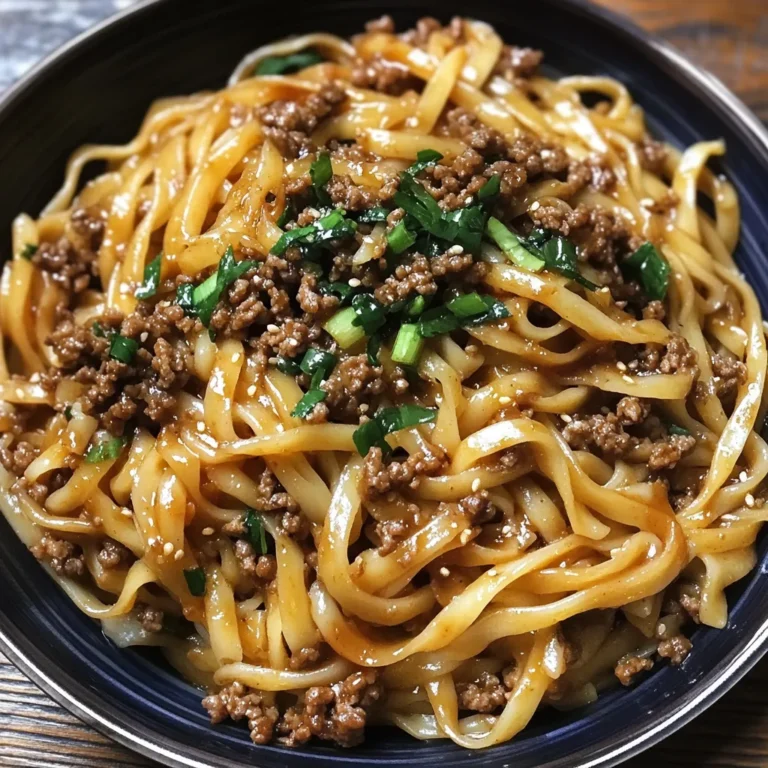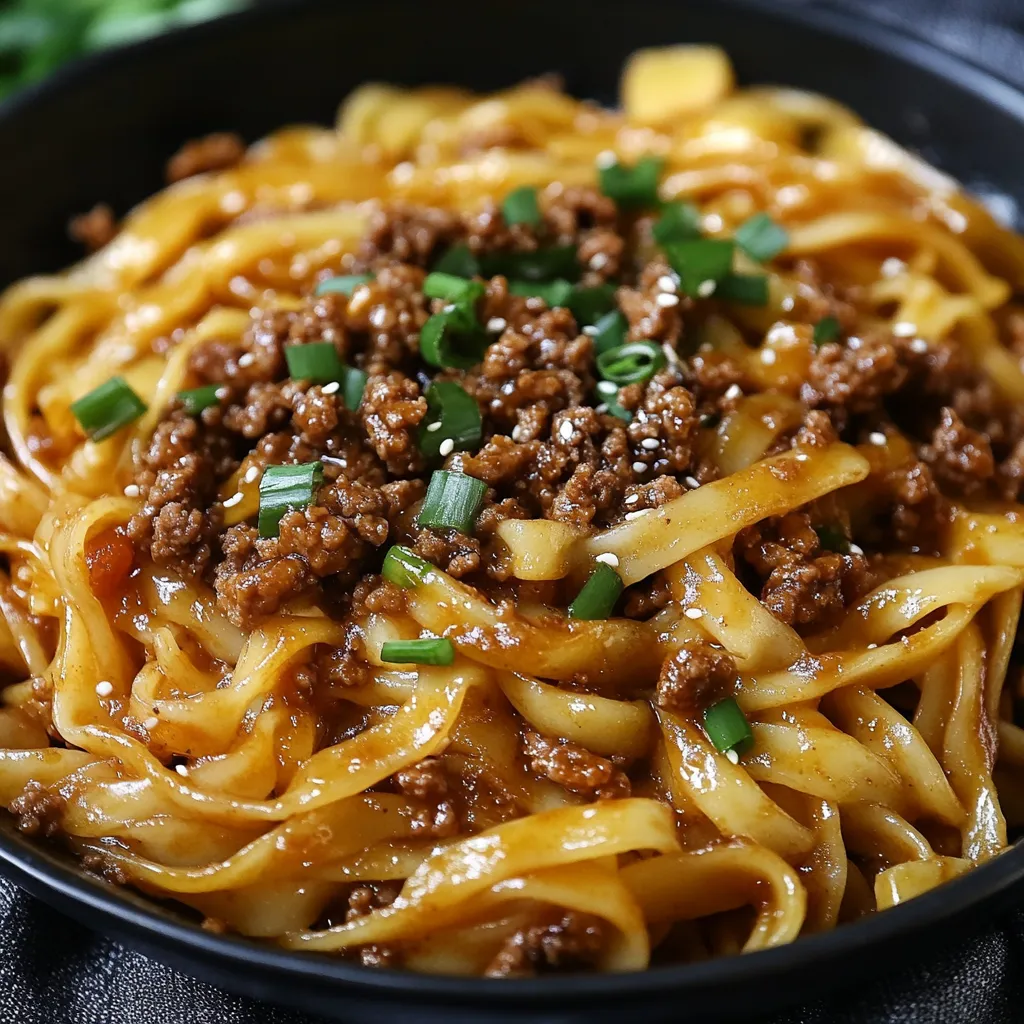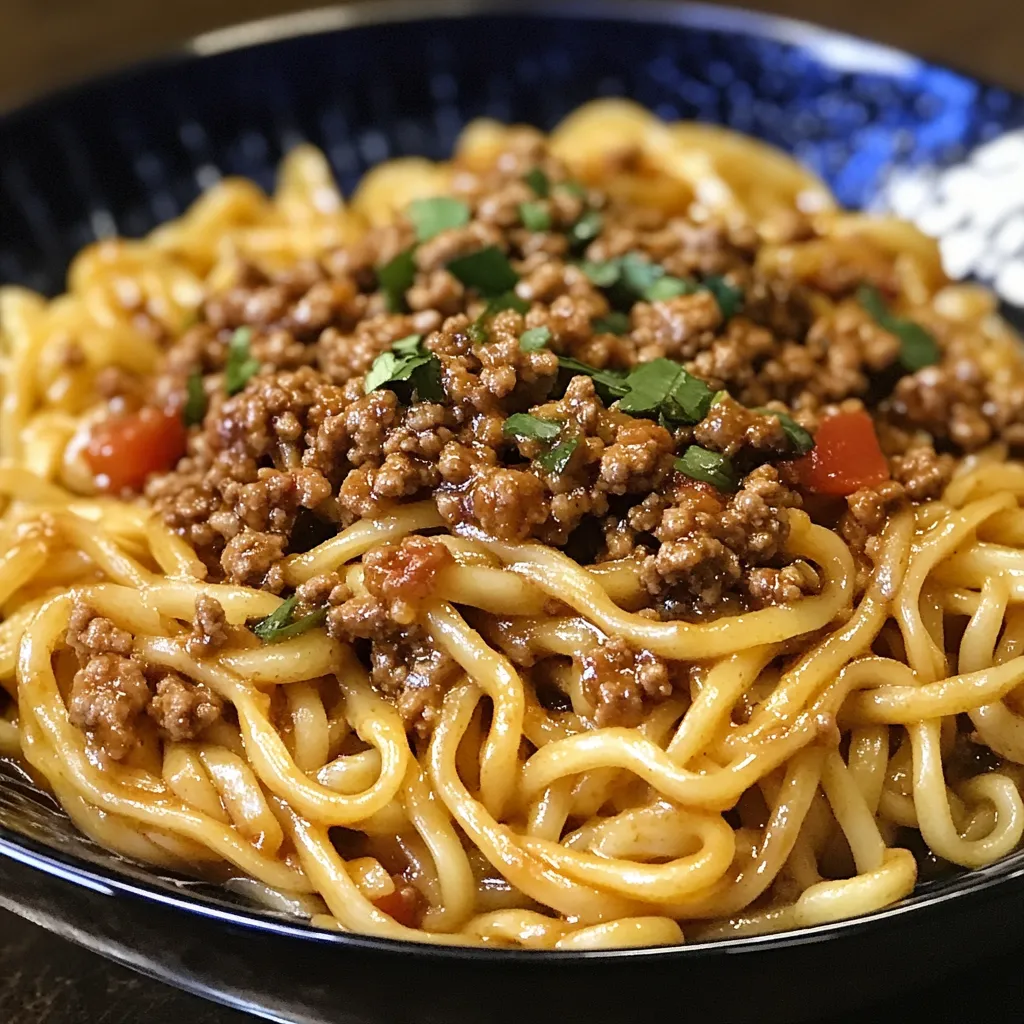Introduction to Mongolian Ground Beef Noodles
What Are Mongolian Ground Beef Noodles?
Mongolian Ground Beef Noodles is a delightful fusion of tender noodles and savory ground beef, bathed in a sweet and tangy sauce. Inspired by the flavors of traditional Mongolian beef dishes, this recipe takes a modern twist by incorporating ground beef for convenience. The result? A comforting and flavorful dish that’s sure to become a family favorite.
Why is this dish so popular?
- Its sweet-savory sauce satisfies a wide range of taste preferences.
- It offers a quick alternative to traditional takeout dishes, making it perfect for busy weeknights.
- With easily accessible ingredients like soy sauce, brown sugar, and garlic, you can recreate restaurant-style flavors at home.
For those wondering how to cook pasta perfectly for this recipe, check out this helpful cooking pasta tips guide to ensure your noodles are always al dente.
Why This Recipe?
This recipe shines for several reasons:
- Healthier alternative: You control the ingredients, allowing for reduced sugar, lower sodium, or the inclusion of fresh veggies.
- Customizable flavors: Adjust the spice level, add your favorite vegetables, or swap proteins to suit your preferences.
- Budget-friendly: Ground beef is affordable and often a freezer staple, making this dish a cost-effective choice.
Unlike some takeout dishes, this recipe uses no exotic or hard-to-find ingredients. Instead, it relies on pantry staples like hoisin sauce and beef broth. If you’re new to experimenting with sauces, this Asian sauces guide offers excellent insights into what makes these flavors pop.
By combining affordability, accessibility, and bold flavors, this dish makes weeknight cooking both easy and enjoyable.
Ingredients and Their Roles
Crafting the perfect Mongolian Ground Beef Noodles starts with understanding the role of each ingredient. Each component is carefully selected to create a balance of flavors, textures, and richness.
Core Ingredients Overview
Here’s a breakdown of the primary ingredients and what they bring to the dish:
- Ground Beef: A highly economical protein choice that absorbs the bold flavors of the sauce while offering a hearty texture. Ground beef is easy to find, making it a go-to option for weeknight meals.
- Linguine: These slippery and absorbent noodles are perfect for soaking up the savory sauce. If you’re unsure how to cook them to the right texture, follow these cooking pasta tips to achieve al dente perfection.
- Soy Sauce, Hoisin Sauce, and Beef Broth: Together, these ingredients create the umami-rich base of the dish. Soy sauce provides saltiness, hoisin adds a touch of sweetness, and beef broth gives depth and complexity.
- Garlic, Ginger, and Spices: These elevate the flavor profile by adding warmth, spice, and an aromatic punch. The inclusion of garlic and ginger is essential for creating that distinct Asian-inspired taste.
Ingredient Substitutions and Tips
This recipe is versatile and adaptable, making it easy to tailor to your preferences or dietary needs:
- Alternative Noodles: Don’t have linguine? Substitute with rice noodles, spaghetti, or udon for a slightly different texture but equally delicious results.
- Protein Swaps: Prefer something other than beef? Chicken, pork, or tofu work wonderfully as substitutes, allowing you to adjust the dish based on your taste or dietary restrictions.
- Adjusting Sweetness and Spice: Customize the sauce by reducing the brown sugar for a less sweet version or adding extra red pepper flakes for a spicier kick. If you’re curious about using hoisin or other sauces, this Asian sauces guide can help you experiment further.
By understanding these ingredients and their roles, you can confidently make adjustments while ensuring the dish retains its rich and satisfying flavor.
Step-by-Step Cooking Process
Mastering the art of making Mongolian Ground Beef Noodles is easy with these straightforward steps. Each stage is designed to maximize flavor while keeping the process simple and efficient.
Cook the Pasta
- Boil the Linguine
- Begin by bringing a large pot of salted water to a boil. Add the linguine and cook according to the package instructions, usually around 8–10 minutes, for an al dente texture.
- Pro tip: Al dente pasta holds its shape better and absorbs the sauce more effectively.
- Prevent Sticking
- Once the pasta is done, drain it thoroughly in a colander. Toss it with a drizzle of olive oil or rinse with warm water to prevent sticking if it will sit for a while before mixing with the sauce.
For additional pasta-cooking tips, refer to this comprehensive guide to ensure perfect results every time.
- Once the pasta is done, drain it thoroughly in a colander. Toss it with a drizzle of olive oil or rinse with warm water to prevent sticking if it will sit for a while before mixing with the sauce.
Prepare the Ground Beef
- Brown the Ground Beef
- Heat a large skillet over medium-high heat. Add the ground beef and cook, breaking it into small pieces, until no longer pink (approximately 5–7 minutes).
- If needed, drain excess grease to keep the dish from becoming overly oily.
- Infuse Flavors
- Reduce the heat slightly and add minced garlic. Stir for 1–2 minutes until the garlic is fragrant, enhancing the beef’s savory profile. For a spicier touch, toss in a pinch of red pepper flakes.
Create the Sauce
- Mix the Sauce Ingredients
- In a bowl, whisk together soy sauce, hoisin sauce, brown sugar, beef broth, ground ginger, and a pinch of black pepper. Pour this mixture into the skillet with the ground beef, stirring to combine.
- Thicken the Sauce
- Dissolve cornstarch in 2 tablespoons of water to form a slurry. Slowly pour the slurry into the skillet while stirring constantly.
- Bring the sauce to a gentle simmer for 2–3 minutes. The cornstarch thickens the mixture, ensuring it clings to the noodles perfectly. For insights into the importance of Asian sauce combinations, explore this guide on sauces.
Combine and Serve
- Mix Pasta and Sauce
- Add the cooked linguine to the skillet, tossing to coat the noodles evenly in the flavorful sauce. Allow it to sit for a minute or two to let the pasta absorb the sauce fully.
- Garnish and Serve
- Top the dish with freshly sliced green onions for a burst of freshness and color. Serve immediately and enjoy your homemade Mongolian Ground Beef Noodles!
With these step-by-step instructions, you’ll have a dish that’s restaurant-quality yet easy to make at home. The key is balancing the textures and flavors in every bite!
The Magic of Mongolian Flavors
Mongolian cuisine has long been a source of inspiration for flavorful, hearty dishes. While the name “Mongolian” evokes images of traditional foods from Mongolia, many popular recipes, like Mongolian Ground Beef Noodles, are adaptations created in Western kitchens to mimic the essence of Asian flavors.
Origins of Mongolian Cuisine-Inspired Dishes
Contrary to popular belief, most “Mongolian” dishes we enjoy in the West, including Mongolian beef, have little connection to traditional Mongolian cuisine. They are, instead, Asian-American creations that draw inspiration from Chinese cooking techniques and ingredients.
The magic lies in their key flavor profiles:
- Sweet: Provided by ingredients like brown sugar or hoisin sauce, which balance the savory notes.
- Savory: Achieved through soy sauce and beef broth, which add depth and umami.
- Spicy: A subtle kick, often from red pepper flakes, makes the flavors more dynamic and appealing.
These adapted dishes aim to capture the bold, rich, and balanced flavors that are synonymous with Mongolian-inspired meals. If you’re curious about the sauces that make these flavors pop, check out this helpful guide on Asian sauces for inspiration.
Why Ground Beef Works in This Recipe
Ground beef is the perfect protein for this recipe because:
- Quick-Cooking: It browns and cooks in minutes, making it ideal for fast, weeknight meals.
- Flavor-Absorbing: Its texture allows it to soak up the sweet-savory sauce, ensuring every bite is flavorful.
- Widely Available: Ground beef is affordable and commonly stocked in most kitchens, making this dish both accessible and budget-friendly.
By combining the simplicity of ground beef with the vibrant flavors of Mongolian-inspired cooking, this dish delivers the best of both worlds: authentic taste and modern convenience.
Tips for the Perfect Dish
Making the perfect Mongolian Ground Beef Noodles is all about mastering a few key techniques and customization options. Follow these tips to ensure your dish is consistently delicious.
How to Prevent Overcooking Noodles
- Cook to Al Dente: Always cook your pasta slightly underdone (al dente) so it maintains its texture when mixed with the sauce. Overcooked noodles can become mushy and fail to absorb the sauce properly.
- Rinse or Toss in Oil: If you’re not combining the pasta with the sauce immediately, rinse it under cold water to stop the cooking process and toss it with a small amount of oil to prevent sticking.
Ensuring the Beef Stays Juicy and Flavorful
- Don’t Overcook: Cook ground beef just until it’s no longer pink to prevent it from drying out.
- Infuse Flavors: Add garlic and spices as the beef cooks to enhance its savory profile, ensuring every bite is packed with umami goodness.
For tips on using beef effectively in quick recipes, check out this ground beef recipe guide.
Adjusting the Sauce to Personal Taste Preferences
- For More Sweetness: Add an extra teaspoon of brown sugar.
- For More Spice: Increase the red pepper flakes or drizzle in a bit of sriracha.
- Lower Sodium Options: Use low-sodium soy sauce and beef broth to control saltiness.
Making Ahead and Reheating Tips
- Storage: Store in an airtight container in the refrigerator for up to 3 days.
- Reheating: Warm gently on the stove with a splash of water or broth to refresh the sauce and prevent drying out.
- Meal Prep: Cook pasta and sauce separately, then combine them fresh when reheating for the best texture and flavor.
With these tips, you can confidently prepare a dish that’s flavorful, perfectly cooked, and easy to enjoy any day of the week!
Variations and Customizations
Mongolian Ground Beef Noodles is a versatile dish that you can easily adapt to suit your dietary preferences or flavor cravings. These customizations ensure your meal is always fresh and exciting.
Adding Vegetables
Boost the nutritional value and texture of this dish by incorporating vegetables. Some great options include:
- Broccoli: Adds a crunch and soaks up the sauce beautifully.
- Bell Peppers: Brightens the dish with a sweet and crisp bite.
- Snap Peas: Perfect for their slight sweetness and crunchy texture.
To keep vegetables vibrant and flavorful, lightly steam or sauté them before mixing with the noodles.
Turning It into a Low-Carb Dish
For those following a low-carb lifestyle, replacing linguine with healthier alternatives is a fantastic option:
- Zucchini Noodles: Spiralized zucchini provides a light and fresh base that pairs well with the savory sauce.
- Cauliflower Rice: A great low-carb substitute that absorbs flavors while adding a unique texture.
Check out this helpful guide to low-carb vegetables for more ideas on substitutions.
Experimenting with Heat Levels
Add a kick of spice to elevate the dish:
- Extra Red Pepper Flakes: Sprinkle more for a subtle increase in heat.
- Sriracha: Drizzle over the top for bold, spicy undertones.
You can tailor the heat level to suit your palate, making the dish milder or spicier depending on your mood.
By exploring these variations, you can transform Mongolian Ground Beef Noodles into a dish that fits your unique taste and dietary needs every time!
FAQs for Mongolian Ground Beef Noodles
If you’re preparing Mongolian Ground Beef Noodles for the first time or looking to make adjustments, these frequently asked questions have you covered.
Can I Use a Different Type of Noodle?
Absolutely! While linguine is commonly used for its slippery and absorbent texture, you can substitute it with:
- Rice Noodles: Perfect for a more authentic Asian flair.
- Spaghetti: A pantry staple that works well as a substitute.
- Udon Noodles: Adds a thick and chewy texture.
The choice of noodles depends on your preference, but ensuring they’re cooked al dente is key. For tips on cooking different noodle types, explore this cooking pasta guide.
Is This Dish Spicy? How Can I Adjust the Spice?
This dish is mildly spicy due to optional red pepper flakes. To adjust the spice level:
- For Less Heat: Omit the red pepper flakes entirely.
- For More Heat: Add extra flakes, sriracha, or chili oil for a bolder kick.
Can This Recipe Be Made Gluten-Free?
Yes! Substitute the regular soy sauce with gluten-free soy sauce or tamari, and opt for gluten-free noodles such as rice noodles or zoodles. This tweak makes the dish suitable for those with gluten sensitivities.
How Do I Store and Reheat Leftovers?
- Storage: Place leftovers in an airtight container and refrigerate for up to 3 days.
- Reheating: Warm on the stove with a splash of broth or water to refresh the sauce and keep the noodles from drying out.
For detailed tips, check out this guide on reheating pasta dishes.
What’s the Difference Between Mongolian Beef and This Dish?
Traditional Mongolian Beef uses slices of flank steak stir-fried with vegetables, whereas this recipe simplifies the process by using ground beef and noodles. The flavor profiles are similar, but the inclusion of noodles makes it a hearty one-dish meal.
By understanding these FAQs, you can customize and enjoy this dish with ease and confidence!
Serving and Pairing Suggestions
Mongolian Ground Beef Noodles is a satisfying main dish, but pairing it with complementary sides and drinks can elevate your meal to a whole new level.
Ideal Side Dishes
- Steamed Vegetables: Broccoli, snap peas, or carrots add a nutritious, crunchy contrast to the rich noodles.
- Egg Rolls: Crispy and savory, egg rolls make a perfect appetizer or side.
- Light Salad: A refreshing cucumber or mixed greens salad with a tangy sesame dressing balances the dish’s bold flavors.
For more inspiration, explore this list of Asian-inspired side dishes.
Drink Pairings
- Iced Green Tea: Its mild flavor complements the noodles without overpowering the dish.
- Crisp White Wine: A Sauvignon Blanc or Pinot Grigio pairs beautifully with the sweet and savory sauce.
- Sparkling Water with Lime: A non-alcoholic option that refreshes your palate between bites.
These pairings ensure your meal is balanced, flavorful, and enjoyable from start to finish!
Conclusion
Mongolian Ground Beef Noodles is the ultimate dish for anyone seeking a quick, flavorful, and satisfying meal. Combining tender noodles, savory ground beef, and a rich, sweet-savory sauce, it delivers restaurant-quality flavor right at home.
Why should this recipe be on your must-try list?
- Quick and Easy: Ready in under 30 minutes, it’s perfect for weeknight dinners.
- Customizable: Whether you prefer extra spice, added vegetables, or alternative proteins, this dish adapts effortlessly to your preferences.
- Budget-Friendly: With simple, affordable ingredients like ground beef and soy sauce, it’s a cost-effective way to enjoy a gourmet-style meal.
Encourage your culinary creativity! Try experimenting with different noodles, proteins, or vegetables to make the dish uniquely yours. For ideas on how to enhance flavors, check out this guide on Asian sauces.
With its rich flavors and endless versatility, Mongolian Ground Beef Noodles is a dish you’ll return to time and again. Give it a try, and discover just how delightful homemade takeout-inspired cuisine can be!
PrintQuick and Easy Mongolian Ground Beef Noodles Recipe
A quick and flavorful dish featuring tender linguine, savory ground beef, and a sweet-savory sauce. Perfect for weeknight dinners, it combines budget-friendly ingredients with restaurant-quality taste.
- Prep Time: 10 minutes
- Cook Time: 15 minutes
- Total Time: 25 minutes
- Yield: 4 servings 1x
- Category: Main Course
- Method: Stir-Fry
- Cuisine: Asian-Inspired
Ingredients
- 1 lb ground beef
- 5 cloves garlic, minced
- 1/3 cup brown sugar
- 1/4 cup beef broth
- 1/3 cup soy sauce
- 3 tablespoons hoisin sauce
- 1/2 teaspoon ground ginger
- 1/2 teaspoon ground black pepper
- Pinch of red pepper flakes (optional)
- 10 oz linguine
- 1 tablespoon cornstarch
- 2 tablespoons water
- 4 green onions, sliced
Instructions
Instructions
- Cook linguine according to package instructions. Drain and set aside.
- Brown ground beef in a skillet, drain excess fat. Add garlic and cook until fragrant.
- Mix soy sauce, hoisin sauce, beef broth, brown sugar, ginger, and pepper. Add to skillet.
- Dissolve cornstarch in water; stir into the skillet to thicken the sauce.
- Add linguine and toss to coat in sauce.
- Garnish with green onions and serve immediately.
Notes
- Adjust sweetness or spice to taste.
- Add vegetables like broccoli or bell peppers for extra nutrition.
- For gluten-free, use tamari and gluten-free noodles.
Nutrition
- Calories: 450
- Sugar: 13g
- Sodium: 980mg
- Fat: 14g
- Saturated Fat: 6g
- Carbohydrates: 58g
- Fiber: 3g
- Protein: 22g
- Cholesterol: 55mg





